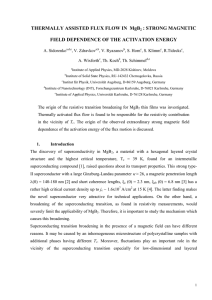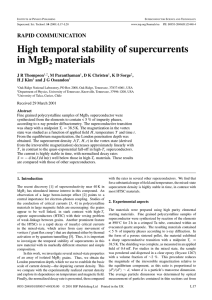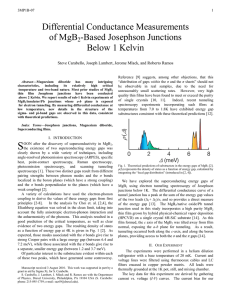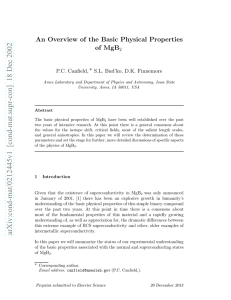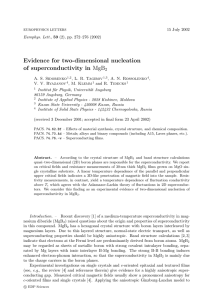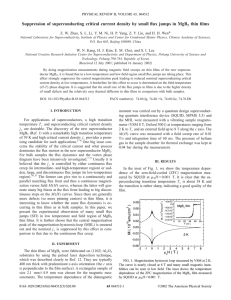THERMALLY ASSISTED FLUX FLOW IN MgB
advertisement
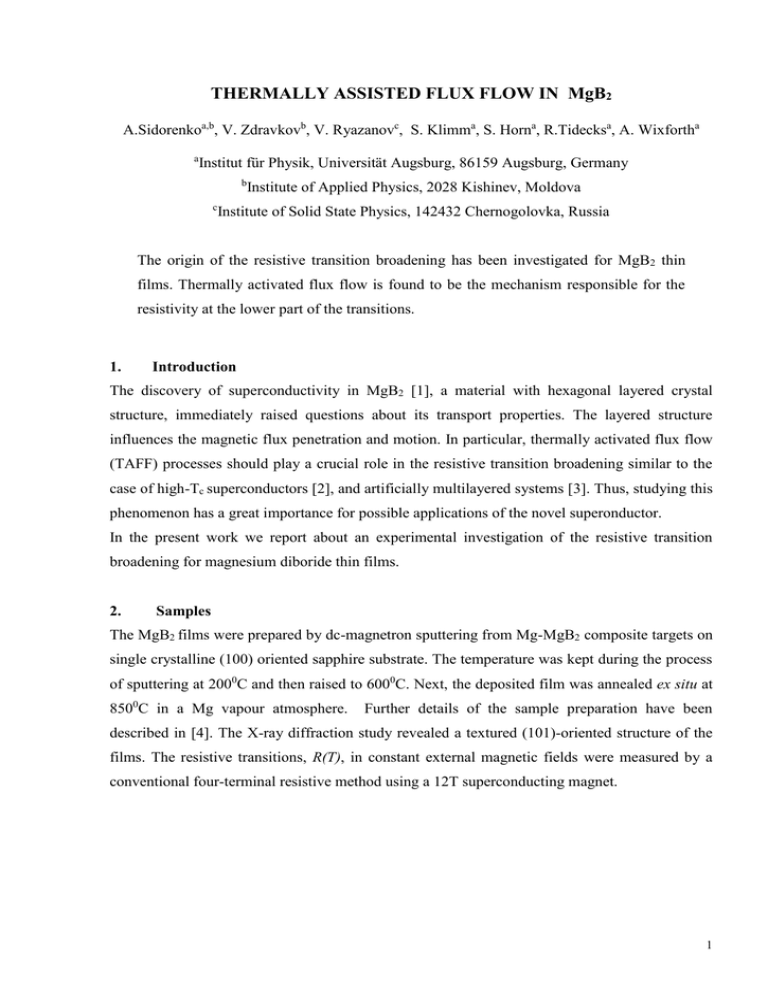
THERMALLY ASSISTED FLUX FLOW IN MgB2 A.Sidorenkoa,b, V. Zdravkovb, V. Ryazanovc, S. Klimma, S. Horna, R.Tidecksa, A. Wixfortha a Institut für Physik, Universität Augsburg, 86159 Augsburg, Germany b c Institute of Applied Physics, 2028 Kishinev, Moldova Institute of Solid State Physics, 142432 Chernogolovka, Russia The origin of the resistive transition broadening has been investigated for MgB2 thin films. Thermally activated flux flow is found to be the mechanism responsible for the resistivity at the lower part of the transitions. 1. Introduction The discovery of superconductivity in MgB2 [1], a material with hexagonal layered crystal structure, immediately raised questions about its transport properties. The layered structure influences the magnetic flux penetration and motion. In particular, thermally activated flux flow (TAFF) processes should play a crucial role in the resistive transition broadening similar to the case of high-Tc superconductors [2], and artificially multilayered systems [3]. Thus, studying this phenomenon has a great importance for possible applications of the novel superonductor. In the present work we report about an experimental investigation of the resistive transition broadening for magnesium diboride thin films. 2. Samples The MgB2 films were prepared by dc-magnetron sputtering from Mg-MgB2 composite targets on single crystalline (100) oriented sapphire substrate. The temperature was kept during the process of sputtering at 2000C and then raised to 6000C. Next, the deposited film was annealed ex situ at 8500C in a Mg vapour atmosphere. Further details of the sample preparation have been described in [4]. The X-ray diffraction study revealed a textured (101)-oriented structure of the films. The resistive transitions, R(T), in constant external magnetic fields were measured by a conventional four-terminal resistive method using a 12T superconducting magnet. 1 3. Results and Discussion Fig.1 shows the resistive transitions R(T) at several magnetic fields, B , perpendicular to the MgB2 film plane for one of the investigated samples. The width of transition is about 0.3K in zero and low magnetic fields and increases up to ~2K for high fields. Usually, the broadening of the resistive transition in a magnetic field for layered superconductors is interpreted in terms of a dissipation of energy caused by the motion of vortices. This interpretation is based on the fact that for the low-resistance region, R<<Rn (where Rn is the resistivity in the normal state just above the transition), the R(T) dependences are of the thermally activated type and may be described by: R R0 exp U ( B, T ) / k BT (1) Here, U(B,T) is the activation energy and R0 is a proportionality factor. Investigation of high-Tc superconductors and artificial multilayers showed, that U(B,T) has different power-law dependences on magnetic field and temperature [2,3]. 102 70 101 60 100 50 7 5 4 3 2 1 0 R (W) R (W) 80 40 10-1 7 10-2 30 5 10-3 20 10-4 10 0 20 22 24 26 28 30 32 34 36 T (K) Fig. 1. The resistive transitions, R(T) , for a 500 nm thick MgB2 film at different values of the magnetic field perpendicular to the film: curve 0 to 7 correspond to B=0, 1, 2, 3, 4, 5, 7 Tesla. 10-5 0 0.030 1 2 0.035 3 4 0.040 0.045 0.050 1 / T (K-1) Fig. 2. Arrhenius plot of R(T)B=const for the sample, presented in Fig.1. From the slope of the linear parts of the curves the value of the activation energy U(B,T) is obtained. Fig. 2 presents an Arrhenius plot of the data of Fig.1, i.e. lnR is plotted against 1/T. The stright line parts indicate that the resistive behavior of the MgB2 film is caused by TAFF-process described by the Arrhenius law given in Eq.(1). 2 A fit of the experimental results R(T)B=const of Fig.2 by Eq.(1) yields values of the activation energy, ranging from U/kB = 300K in low magnetic field up to 10000K in the high field region. Compared to the power law U(B)~Bn with the exponent n ~ 1, usually observed for other layered systems [3,5], MgB2 demonstrates a much stronger field dependence of the activation energy. 4. Conclusion One of the possible reasons of the unusual strong field dependence of the activation energy of the TAFF-process for MgB2 observed in the present work, may be a very complex flux dynamics, such as the dendritic flux instability in MgB2 films, found recently [6] for c-axis textured films in a magnetic field perpendicular to the film plane. The magneto-optcal imaging measurements demonstrate a „fractal-like“ structure of the flux penetration with strong increase of the flux-dendrits quantity with increasing magnetic field. This unusual flux creep behavior of magnesium diboride needs further investigation. Acknowlegments This work was partially supported by the INTAS-Project Nr.99-00585. References [1] J. Namagatsu, N. Nagakawa, T. Muranaka, Y. Zenitani, J. Akimitsu, Nature 410, 63 (2001). [2] A. P. Malozemoff, Y. Yeshurn, L. Krusin-Elbaum et al., in: High Temperature Superconductivity 9, 112 (1988) (ed. By R. Nicolsky, World Scientific, Singapore, 1988). [3] N. Fogel, V. G. Cherkasova, O. A. Koretzkaya, A. S. Sidorenko, Phys. Rev. B55, 85 (1997). [4] A. S. Sidorenko, L. R. Tagirov, A. N. Rossolenko, N. S. Sidorov, V. I. Zdravkov, V. V. Ryazanov, M. Klemm, S. Horn, R. Tidecks, JETP Letters 76, 20 (2002). [5] T. M. Palstra, B. Batlogg, R. B. van Dover, L. F. Schneemeyer, and J. V. Waszchak, Phys. Rev. B41, 6621 (1990). [6] T. H. Johansen, M. Bazilevich, D. V. Shantsev, P. E. Goa, Y. M. Galperin, W. N. Kang, H. J. Kim, E. M. Choi, M.-S. Kim, S. I. Lee, Submitted to Science (2002). 3

